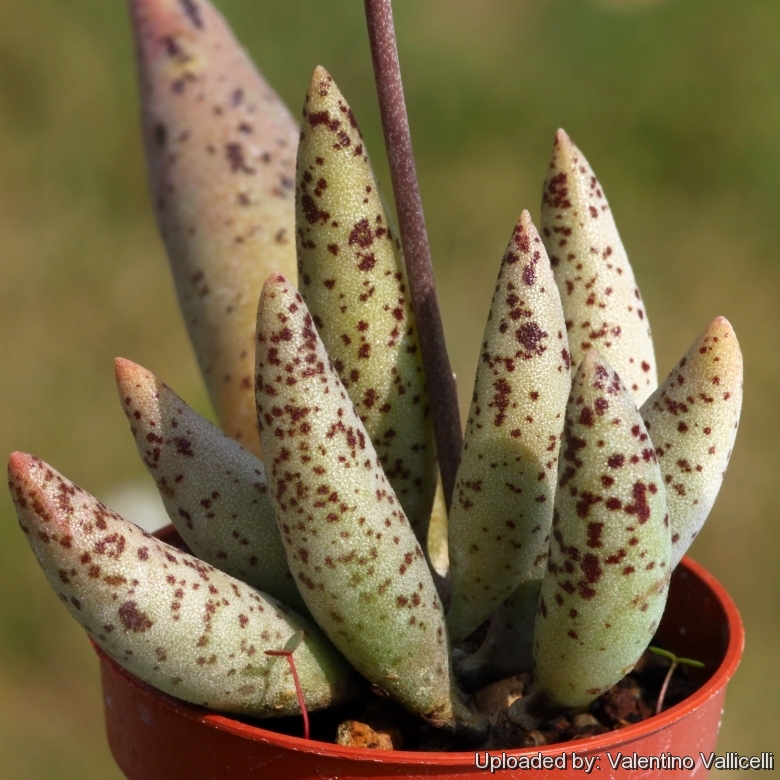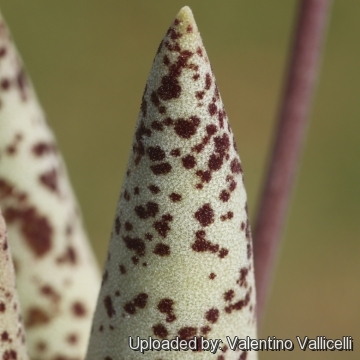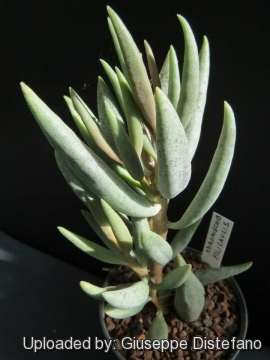Accepted Scientific Name: Adromischus filicaulis (Eckl. & Zeyh.) C.A.Sm.
Bothalia 3: 630 1939

Adromischus mammillaris var. filicaulis (Adromischus filicaulis) Photo by: Valentino Vallicelli
Origin and Habitat: Richtersveld to the Knersvlakte in western South Africa.
Habitat: Plants grow on exfoliating granites on low hills at altitudes ranging from 200-250 m, in full sun, near or in False Fynbos with mixed succulent vegetation that includes Ruschia caroli, Poellnitzia rubrifloraSN|31537]]SN|31537]], Conophytum pageae and Conophytum ficiforme.
Synonyms:
See all synonyms of Adromischus filicaulis
Common Names include:
AFRIKAANS (Afrikaans): Brosplakkies
Description: Adromischns filicaulis (A.fragilis) is a highly variable and very slow growing adromischus usually with shiny grey-green leaves and rust coloured spots and margins.
Note: Two subspecies are recognized, the nominate form and subsp. marlothii (A. marlothii, A. tricolor), but much variation has been recorded for this species that it might seem unnatural to divide it into two subspecies. The main difference is the presence or absence of stiff stilt roots.
Stems: Branchlets simple, stout, elongate, erect or decumbent, 7-12 mm across up to 35 cm long, rarely with stilt adventitious roots.
Roots: Fibrous.
Leaves: 2-8 cm long, 5-15 mm broad, oblanceolate, elliptic to oblong, or linear-elliptic and almost terete (cylindrical), often spindle-shaped, narrowed on both sides, often distinctly flattened above grey-green to greyish brown,with or without dark spots. Moreover seedlings often begin with flat leaves. After the plant ages, the leaves will become terete. Tip acute or obtuse; base abruptly wedge-shaped. Margin horny, slightly expanded.
Inflorescences: The flowering spike is 200-350 mm tall. Buds terete. abruptly narrowed towards tip, spreading. Flowers 1-1.3 cm, yellowish green, corolla tube yellowish-green tinged pink, lobes broadly triangular, white or pale yellow, tinged from pink to deep red with mauve mucro, rough, without club-shaped hairs. Anthers protruding from corolla-tube.
Subspecies, varieties, forms and cultivars of plants belonging to the Adromischus filicaulis group
 Adromischus filicaulis (Eckl. & Zeyh.) C.A.Sm.: has stems 7-12 mm across up to 35 cm long usually not rooting. Leaves spindle-shaped to flattened, with or without dark spots. Distribution: Richtersveld to the Knersvlakte
Adromischus filicaulis (Eckl. & Zeyh.) C.A.Sm.: has stems 7-12 mm across up to 35 cm long usually not rooting. Leaves spindle-shaped to flattened, with or without dark spots. Distribution: Richtersveld to the Knersvlakte- Adromischus filicaulis subs. marlothii (Schönland) Toelken: has stem 3-8 mm across, with flaking bark with stilt roots, and mostly linear leaves. Ditribution: Little Karoo (Worcester-Oudtshoorn) and Great Karoo (Laingsburg-Beaufort West)
Bibliography: Major references and further lectures
1) John Pilbeam, Chris Rodgerson, Derek Tribble “Adromischus” Cirio Publishing Services Ltd, 1998
2) Hermann Jacobsen “Abromeitiella to Euphorbia” Blandford Press, 1960
3) Christopher Brickell "WRHS Encyclopedia of Plants and Flowers" Dorling Kindersley Ltd, 01/Sep/2010
4) Ernst Van Jaarsveld, Ben-Erik Van Wyk, Gideon Smith “Succulents of South Africa: A Guide to the Regional Diversity” Tafelberg Publishers, Limited, 01/Jul/2000
5) Hermann Jacobsen “A handbook of succulent plants: descriptions, synonyms, and cultural details for succulents other than Cactaceae” Volume 1 Blandford Press, 1960
6) Dr J.P. Roux “Flora of South Africa” 2003
7) Foden, W. & Potter, L. 2005. Adromischus filicaulis (Eckl. & Zeyh.) C.A.Sm. subsp. filicaulis. "National Assessment: Red List of South African Plants" version 2014.1. Accessed on 2014/06/03
 Adromischus mammillaris var. filicaulis (Adromischus filicaulis) Photo by: Giuseppe Distefano
Adromischus mammillaris var. filicaulis (Adromischus filicaulis) Photo by: Giuseppe Distefano Adromischus mammillaris var. filicaulis (Adromischus filicaulis) Photo by: Valentino Vallicelli
Adromischus mammillaris var. filicaulis (Adromischus filicaulis) Photo by: Valentino Vallicelli Adromischus mammillaris var. filicaulis (Adromischus filicaulis) Photo by: Giuseppe Distefano
Adromischus mammillaris var. filicaulis (Adromischus filicaulis) Photo by: Giuseppe DistefanoSend a photo of this plant.The gallery now contains thousands of pictures, however it is possible to do even more. We are, of course, seeking photos of species not yet shown in the gallery but not only that, we are also looking for better pictures than those already present.
Read More... Cultivation and Propagation: Adromischus filicaulisSN|27682]]SN|27682]] is a most beautiful succulent but rarely seen in cultivation. It is not the easiest species to cultivate, and highly prone to rotting off, both at the height of winter or summer.
Growth rate: It is a relatively fast growing species.
Soil: Use mineral well-permeable substratum with very little organic matter (peat, humus). It needs perfect drainage to flourish.
Repotting: Repotting every 2-3 years. As it is especially prone to rot under-pot in a smaller container filled with very porous compost. Use pot with good drainage. All species of this genus are happy in small pots.
Exposure: It grows best in a partially shaded position. It got sunburned if exposed to midday sun.
Hardiness: Require a minimum temperature 5°C (But hardy down to -7°C for short periods), with good drainage and dryness in winter to resist the cold.
Watering: It takes more water than cacti, but let the soil dry between soaking, in the wild, it receives rain mostly in spring and fall. Must have very dry atmosphere. Water less in winter but do not allow it to shrivel.
Pest & disease: It is vulnerable to mealybugs and rarely scale. It is prone to rotting from the tuberous base or from dried inflorescences. If the plants are not watered and “aired” correctly, fungicides won't help all that much.
Maintenance: The long stems of Adromischus filicaulisSN|27682]]SN|27682]] need to be cut back to encourage clustering from the base. As the plant matures, the centre becomes bare. Remove flower spikes before winter.
Propagation: Adromischus seeds are very small and seed propagation is rarely used. Usually propagate from single leaves (leaf cuttings) or stem cuttings. Leaves easily root and produce new plants. Twist off a leaf and permit it to dry out a couple of days, lay it on the soil and insert the stem end partially into the soil. The original leaf should not be removed until it has dried up. Try to keep the leaf somewhat upright so that the roots are able to grow downward. If grown in a container, bottom watering by immersing the container is recommended.














